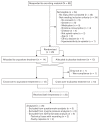The Impact of Opioid Treatment on Regional Gastrointestinal Transit
- PMID: 26811503
- PMCID: PMC4819867
- DOI: 10.5056/jnm15175
The Impact of Opioid Treatment on Regional Gastrointestinal Transit
Abstract
Background/aims: To employ an experimental model of opioid-induced bowel dysfunction in healthy human volunteers, and evaluate the impact ofopioid treatment compared to placebo on gastrointestinal (GI) symptoms and motility assessed by questionnaires and regional GItransit times using the 3-dimensional (3D)-Transit system.
Methods: Twenty-five healthy males were randomly assigned to oxycodone or placebo for 5 days in a double blind, crossover design. AdverseGI effects were measured with the bowel function index, gastrointestinal symptom rating scale, patient assessment of constipationsymptom questionnaire, and Bristol stool form scale. Regional GI transit times were determined using the 3D-Transit system, and segmental transit times in the colon were determined using a custom Matlab(®) graphical user interface.
Results: GI symptom scores increased significantly across all applied GI questionnaires during opioid treatment. Oxycodone increased median total GI transit time from 22.2 to 43.9 hours (P < 0.001), segmental transit times in the cecum and ascending colon from 5.7 to 9.9 hours (P = 0.012), rectosigmoid colon transit from 2.7 to 9.0 hours (P = 0.044), and colorectal transit time from 18.6 to 38.6 hours (P= 0.001). No associations between questionnaire scores and segmental transit times were detected.
Conclusions: Self-assessed GI adverse effects and increased GI transit times in different segments were induced during oxycodone treatment. This detailed information about segmental changes in motility has great potential for future interventional head-to-head trials of different laxative regimes for prevention and treatment of constipation.
Keywords: Analgesics; Constipation; Gastrointestinal transit; Opioid.
Figures



References
-
- Tamayo AC, Diaz-Zuluaga PA. Management of opioid-induced bowel dysfunction in cancer patients. Support Care Cancer. 2004;12:613–618. - PubMed
LinkOut - more resources
Full Text Sources
Other Literature Sources

